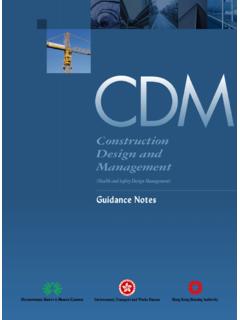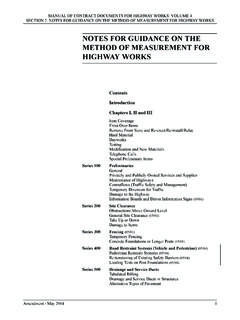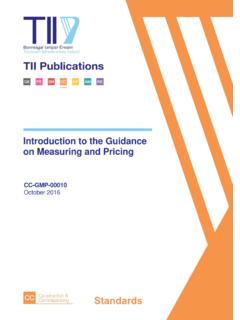Transcription of The Use of Lump Sum Bills of Quantities Contracts for ...
1 Appendix A WBTC No. 17/95 Appendix A 1 of 3 Practice Note for The Use of Lump Sum Bills of Quantities Contracts for civil engineering Works 1. For pure lump sum Contracts the Contractor undertakes to carry out a defined amount of work in return for an agreed price. Once the work is done, the price is paid. 2. In our Contracts the price is usually paid in stages, which may be subject to a price fluctuation clause. When it is not, it is described as a "fixed price" contract . The price is also adjusted for the effect of any variation ordered to the design of the Works and for adjustments for the Contingency Sum, any Provisional Sum, Prime Cost Sum etc.
2 As stated in the contract and for any error discovered in the Quantities (if included). 3. It is clear that when we use the term "lump sum" we do not mean it strictly in the way it is used in para. 1. When we let a contract based on Bills of Quantities we further complicate the issue, because it is almost certain that when we go to tender not every detail of the design will be finalised and these unfinalised details cannot be measured accurately (referred to as "firm" Quantities /items). The term "lump sum" is therefore a convenient way to differentiate this approach from total remeasurement (and other Contracts ).
3 4. Lump sum Contracts with Bills of Quantities are priced on the basis of the drawings and specification, reduced by means of a standard method of measurement to a list of items which describe and measure the work included on the drawings and in the specification. Any item or section of work which cannot be accurately measured is covered by a provisional quantity or sum and measured as executed on completion of the item or section of work the value of the provisional item(s) or section(s) of work in the Bills is/are deducted from the contract Sum and the value of the work executed is added.
4 5. The "details" referred in para 3 can be substantial. For example, in the building industry the whole of the substructure and much of the external works may be described as provisional and are remeasured as done. This does not prevent the contract from being described and treated as lump sum of a substantial part of the Works can be measured accurately for inclusion in the Bills . 6. The provisional Quantities are included in the Bills wherever it is appropriate and sensible to do Appendix A WBTC No. 17/95 Appendix A 2 of 3 so.
5 Individual items to be remeasured can be mixed in with the "firm" items, or a whole section can be shown separately and described as provisional. It is very important to clearly differentiate items of work that are not measured firm, by marking each item (or group of items) "provisional" and explaining the process of adjustment elsewhere in the contract . ( in the Preliminaries/Preambles). 7. General Conditions of contract (GCC) Clause 5 - Documents mutually explanatory, takes on more importance in lump sum Contracts .
6 The agreement is that the work to be done is accurately reflected in the Bills . Any failure to do so places an obligation on the Engineer to put it right. (See the reference in sub-clause (4) proviso (a) to GCC Clause 59, which is replaced by the SCC attached at Annex 3 and para 10(a) following.) Any other discrepancy between the various contract documents must be sorted out as though it were a variation. It is for the Contractor to prove that a discrepancy or an error in measurement exists. 8. Lump sum Contracts often result in a heavier use of GCC Clause 60 - Variations.
7 The provisional Quantities are dealt with in the same way as estimated Quantities in remeasurement Contracts . The proviso to GCC Clause 61(1) the valuing of the "knock-on" effect of varied work on the unvaried, also takes on more importance in lump sum Contracts . It is therefore very important to make sure that the design of the parts of the works measured as firm will not be subject to variations or lack detail that can produce an extension of time and disruption/prolongation claims. 9. The measure and value of each variation ordered is collected together into a " bill of variations" the net total of which is added to or omitted from the contract Sum (together with the effect of any remeasured items or sections, the Contingency Sum adjustment etc.)
8 The measure and value must be completed by the Engineer (but not necessarily agreed with the Contractor) within the contractually stated period. (See SCC covering GCC Clause 59(7) on page 4 of Annex 3). 10. Most of the changes to the General Conditions of contract introduced by the Special Conditions of contract , bring the civil engineering version into line with the Building version, generally using the same wording. There are exceptions viz - (a) Clause 50(1)(b)(v) - Whilst the wording is changed, the purpose remains the same an extension of time is only considered if the increase in quantity is produced by other than an error in or omission of firm Quantities ( provisional Quantities are under- Appendix A WBTC No.)
9 17/95 Appendix A 3 of 3 estimated) because the work shown on the Drawings and/or in the Specification does not change, and therefore there is no reason why the time for completion should change. With provisional Quantities the work can increase and therefore such increases should be considered for an extension of time. If the work shown on the Drawings and/or in Specification changes, this is a variation. (See Annex 1 examples). (b) Clause 59(3) - the words "work required by the (Engineer) to be carried out" do not appear in the SCC.
10 This reflects differing procedures between the civil engineering and building approaches. (For the latter, Clause 5 would be operated by the Contractor.) This difference does not change the outcome, items of work shown on the Drawings or described in the Specification which are required to be measured under the rules of the standard method of measurement must be so measured. (c) Clause 59(4)(a) - includes an additional final sentence, again in order to assist the Engineer. (d) Clause 59(6)(b) and (c) and (7) - describe the procedures applicable to civil engineering , but require the Engineer to complete (but not necessarily agree with the contractor) the final measure and valuation in respect of work required to be measured under Clause 59(3), within a 30-day period commencing on the date of issue of the maintenance certificate.















